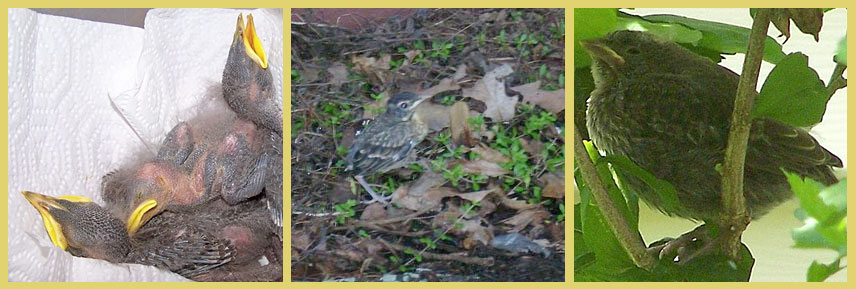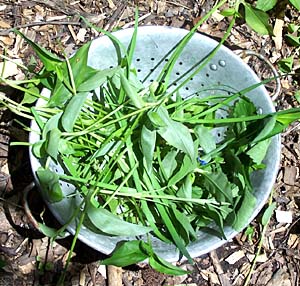What To Do If You Find a Bird That Needs Help
by Carolyn Hasenfratz
I can tell by the amount of food and feeders that we sell that Schnarr’s customers love their backyard birds! Many of us will encounter at some point a bird that is sick or injured or a baby that appears to be abandoned. Right now some birds are starting their second brood of the summer so baby bird season is not over yet!
Baby birds are very vulnerable if they fall or are pushed out of the nest. If you feel compelled to intervene, I totally understand why – that’s how I came to be living with two European Starlings – it’s a long story! Having been through the situation of finding a baby bird more than once, I’ve done a lot of reading and learning from experience and here is what I recommend.
First determine if the bird is a nestling or a fledgling. A nestling will not be fully feathered and will not be able to run away. It needs to be back in a nest ASAP. Try to put the bird back in the original nest if you can and if you know the parents are alive. It’s a myth that the smell of humans will cause the parent birds to abandon it – most birds can’t smell.
Sometimes it’s not possible to put the bird back in the original nest – you can’t find it, you can’t reach it, or it’s been destroyed. If that’s the case you have the following options.
One plan is to make a makeshift nest and put it in a place where the parents can find it and it is safe from predators. If the bird is a species that nests in a cavity, you can look up nest box plans online specifically for that species and build one. I’ve been successful in getting a Starling family to move to a homemade nest box after the babies fell out of a dryer vent. Observe the nest to see if the parents find the baby and start feeding it. If they don’t, take the bird to a wild bird rehab center. It’s hard to say how long you should wait before giving up on the effort to re-involve the parents. The necessary feeding intervals of baby birds can vary depending on how old they are – if in doubt you could call a wild bird rehab center for advice. It’s easy for baby birds to get dehydrated if they go too long without food because most of them don’t drink liquids but get their moisture from their squishy bug diet. Don’t attempt to give the baby bird water or liquids unless you know the right way – it’s very easy to accidentally kill a baby bird by giving it water without knowledge of the correct procedure.
It’s time-consuming to make and observe a makeshift nest – if you have the time, you might find it worthwhile to put in the effort. You’ll learn a lot while doing it and it’s very rewarding! If you don’t have the time or the interest, just take the bird to the nearest wild bird rehab center right away. If it’s one of the three species not protected by federal laws (Pigeons, House Sparrows or European Starlings) the rehabber might either euthanize it or refuse to accept it. In that case you will have a difficult choice to make and having been in that position, I wouldn’t envy you! I chose to raise the five-day-old Starling I found in 2009 rather than let it be killed but everyone does not have the means or desire to take on the job of raising a baby bird. It can be done with the correct knowledge but it’s a big commitment. Raising a baby bird and releasing it to the wild later sounds like a good idea but is not an option if the bird has been raised alone and if you want the bird to survive – it will not have learned survival skills from the parents. It may not know how to act around other wild birds and could fail to be accepted by a wild flock. A protected species (not one of the three mentioned) is not legal to keep without a permit and you must take it to a licensed rehabber to help it.

The baby birds on the left are nestlings and the other two examples are fledglings.
If the bird is fully feathered and can run away and perch, it’s a fledgling. Most fledglings do not need any help. It’s not uncommon for baby birds to leave the nest before they can fly well. The fledgling will be somewhat vulnerable until it can fully fly but the parents should be feeding it and trying to keep it away from danger. The best way to help it is to put it on a perch off the ground (if you can catch it). If you have cats or dogs keep them indoors for a week or so. It’s not good for the health of pet cats to let them outside in any circumstances, but if you must let yours out try not to do so until the fledglings are flying.
If you find a bird that is sick or injured, it will need care no matter what age it is, so in that case try to get it to a rehabber as soon as possible. If a bird does not look sick but has been caught by a dog or cat, it needs antibiotics within a day or so or it is probably doomed. When birds are to the point of showing signs of illness or injury they are in bad shape – their instinct is to hide their infirmity as long as possible so they are not caught by predators or rejected by their flocks. Speaking of sick birds, it is my understanding is that a thorough hand-washing after handling is sufficient precaution in case the bird does have something a human can catch, like Salmonella. I am not a vet or a scientist so get more information on diseases if you are concerned. Many bird-borne diseases are species-specific and can’t be caught by humans. However, if you have disposable gloves on hand it’s smart to wear them for extra protection.
The best way to transport a bird to a rehabber is to put it in a box with soft nest-like materials and cover the box. Make sure it can breathe if it’s boxed or wrapped. The bird will likely be terrified and if it’s confined it will be less likely to injure itself. Handle it as little as possible and try not to expose it to loud noises.
If the bird is really large, like a hawk, heron, goose or pea fowl (which I once rescued believe it or not!), get advice from the Humane Society or other knowledgeable group before attempting to transport. My handling of the peahen I found went very smoothly but without good instructions and remembering to remain calm I might have had trouble! Some large birds can cause serious injuries with talons or beaks if not handled carefully. The peahen I transported had some mean-looking spurs but fortunately did not attempt to use them on me!
For more advice from the experts, please see these links:
I Found A Baby Bird. What Do I Do?
Songbirds
Ducklings or goslings
Birds of prey, vultures, herons, pelicans or swans
Information on raising House Sparrows and Starlings:
Sparrows and Starlings
www.starlingtalk.com – Everything you need to know about raising Starlings and if you want to, living with them permanently

